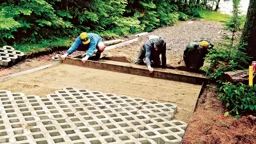Reverse osmosis (RO) water treatment systems, often used to produce drinking water in arid regions, are starting to gain popularity in smaller applications meant for houses and cabins. RO systems effectively remove common water impurities like iron and the “hardness” ions of calcium and magnesium, potential heavy metal contaminants like arsenic, and even harmful bacteria like cryptosporidium. However, there are some downsides to RO systems.
Cost
RO systems typically cost $300–$3,000, and replacement membranes can cost $100–$200. That kind of coin can buy a lot of bottled water or a point-of-use filtration system for much less. You will also incur additional electrical costs for pumping water through the membrane, and household.
Inefficiency
Small, cabin-sized RO systems are meant to provide drinking water and are usually not designed to be a whole-house system, as they typically will only deliver less than 10 gallons of water per day. RO systems also generate a lot of waste, or reject, water – up to 90% of the total water volume used. In other words, it might take 100 gallons of well water to deliver those 10 gallons of ultrapure water. And since those 90 “reject” gallons will be higher in impurities than the original source water, they will probably be destined for the septic system.
Maintenance
The RO membranes also need to be maintained. A sediment pre-filter is necessary to prevent fouling, and the membrane itself can be a growth medium for bacteria. Finally, RO membranes will be degraded when exposed to chlorine, so if you draw water from a city source (or bleach your well) you’ll need to add a carbon filter prior to the RO to buffer out the chlorine’s effects.
But the resulting water is better for you, right? Well, it’s certainly more healthy than drinking water that’s high in heavy metals or contaminated with dangerous bacteria. But RO water is so low in ion content that it’s actually corrosive, and can leach metals from water supply pipes – actually increasing copper or lead in your drinking water. This is not a problem if the water supply pipes after the RO system are made of plastic or cross-linked polyethylene.
Water this low in minerals isn’t necessarily tasty either, and it may not even be all that thirst-quenching. You lose essential minerals in the RO process, and some studies have shown that ultra-low-ion water can have negative health effects in lab animals if consumed regularly.
The bottom line? A cabin RO system is probably only suited for situations where the cabin’s water supply is truly contaminated, or subject to outbreaks of harmful pathogens.
Cost
RO systems typically cost $300–$3,000, and replacement membranes can cost $100–$200. That kind of coin can buy a lot of bottled water or a point-of-use filtration system for much less. You will also incur additional electrical costs for pumping water through the membrane, and household.
Inefficiency
Small, cabin-sized RO systems are meant to provide drinking water and are usually not designed to be a whole-house system, as they typically will only deliver less than 10 gallons of water per day. RO systems also generate a lot of waste, or reject, water – up to 90% of the total water volume used. In other words, it might take 100 gallons of well water to deliver those 10 gallons of ultrapure water. And since those 90 “reject” gallons will be higher in impurities than the original source water, they will probably be destined for the septic system.
Maintenance
The RO membranes also need to be maintained. A sediment pre-filter is necessary to prevent fouling, and the membrane itself can be a growth medium for bacteria. Finally, RO membranes will be degraded when exposed to chlorine, so if you draw water from a city source (or bleach your well) you’ll need to add a carbon filter prior to the RO to buffer out the chlorine’s effects.
But the resulting water is better for you, right? Well, it’s certainly more healthy than drinking water that’s high in heavy metals or contaminated with dangerous bacteria. But RO water is so low in ion content that it’s actually corrosive, and can leach metals from water supply pipes – actually increasing copper or lead in your drinking water. This is not a problem if the water supply pipes after the RO system are made of plastic or cross-linked polyethylene.
Water this low in minerals isn’t necessarily tasty either, and it may not even be all that thirst-quenching. You lose essential minerals in the RO process, and some studies have shown that ultra-low-ion water can have negative health effects in lab animals if consumed regularly.
The bottom line? A cabin RO system is probably only suited for situations where the cabin’s water supply is truly contaminated, or subject to outbreaks of harmful pathogens.
THE WAY IT WORKS
You may remember an experiment from your junior high science class, when the teacher placed a natural sausage casing half-filled with sugary liquid into a water bath. By the next day, the limp casing had filled to near-bursting. How did that happen?
It turns out the water had moved through the permeable casing into the sugar water – nature’s way of equalizing the ion content, or osmotic pressure, in the water bath. Called osmosis, this is a perfectly natural phenomenon.
That basic scientific principle was reversed in the 1940s when scientists used artificial pressure (via pumping) to push water through a semi-permeable membrane. By using a membrane with openings so small only water molecules could move through it, scientists could “screen” impurities – salts, in this case – from brackish water. The reverse osmosis system was born.
You may remember an experiment from your junior high science class, when the teacher placed a natural sausage casing half-filled with sugary liquid into a water bath. By the next day, the limp casing had filled to near-bursting. How did that happen?
It turns out the water had moved through the permeable casing into the sugar water – nature’s way of equalizing the ion content, or osmotic pressure, in the water bath. Called osmosis, this is a perfectly natural phenomenon.
That basic scientific principle was reversed in the 1940s when scientists used artificial pressure (via pumping) to push water through a semi-permeable membrane. By using a membrane with openings so small only water molecules could move through it, scientists could “screen” impurities – salts, in this case – from brackish water. The reverse osmosis system was born.
 Thinkstock.com
Thinkstock.com 









